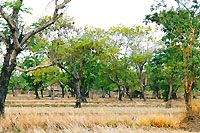| Period: 10 February - 30 March 2003. Country: Laos |
| (1) Secondary Succession of Vegetation and Land
Use System in Savannakhet Province, Laos |
| KOSAKA Yasuyuki (Division
of Southeast Asian Area Studies) |
| Key Words: Midland Laos, Land-Use,
Natural Resource Use, Vegetation, Secondary Succession |

Photo 1: Peltophorum dasyrrhachis
in the paddy field |

Photo 2: Young trees of Peltophorum
dasyrrhachis in the shifting cultivation field |
(2) Hilly plains
spread in midland Laos and northeast Thailand. Dry dipterocarp forest,
mixed deciduous forest, evergreen forest and their substitutive communities
can be found on the undulating terrain consist of Mesozoic era red
sandstone. The objective of this study is to estimate the secondary
succession pattern of the vegetation and to examine the current conditions
of the local land-use system and forest management. (3) The
latest field survey was conducted at Nakhou village and Bak village,
Champhone District in Savannakhet Province, Laos, from 16 March
to 3 April, 2003. Both villages are located on a continuous slope,
with paddy fields spreading over the lowland from Nakhou village
to the center of Bak village, and shifting cultivation being performed
on the higher land. Some water sources were found around Bak village,
which is on the boundary between the paddy field zone and the shifting
cultivation zone. A vegetation survey inside and around the cultivated
land and an interview survey regarding the former vegetation and
useful plants were conducted at both villages.
First,
at Nakhou village, all (2,000) trees standing in the paddy fields
along both sides of the village road (3 km long and 100 m wide)
were measured, and the species name, DBH, height and location were
recorded. Among them, 89 species were growing naturally, 20 species
had been planted by villagers, and five of the planted species were
considered to be able to regenerate naturally after planting. In
the interview survey, villagers mentioned that the trees in the
paddy fields (Photo 1) promoted the growth of rice plants, offered
shade to both livestock and humans, and provided important fuel
for the village, which has only little wooded land. It is also said
that there has once been large numbers of large trees such as Dipterocarpus
alatus and Pterocarpus macrocarpus, but that they
had all been logged.
Next,
at Bak village, we selected study plots that had been slashed and
burned one year ago, four years ago, nine years ago, and more than
20 years ago, as well as the conservation area. It is said that
large trees of Dipterocarpus alatus, Pterocarpus macrocarpus
and other valuable species had been logged around this area in the
1970s, the era of revolution. The plot survey showed that many seedlings
of Peltophorum dasyrrhachis sprouted after burning and
grew among the crops such as pineapple, banana, etc. (Photo 2).
In one plot, more than 20 years after burning, the seedlings of
climax species such as Dipterocarpus alatus, Dalbergia
sp., etc., were growing under a canopy of Peltophorum
dasyrrhachis and Dialium cochinchinense. This secondary
forest produces many types of NTFPs, such as cardamon, shoots and
fruits of rattan, etc. On the other hand, in the conservation area
where valuab trees had been formerly logged, but where burning was
not performed, we could not find any Peltophorum dasyrrhachis.
These
findings suggest the following secondary succession of vegetation
around the research site. Formerly, evergreen forest and mixed deciduous
forest abundant in Dipterocarpus alatus and Pterocarpus
macrocarpus were widespread. After people settled, paddy fields
were established in the lowland, whereas shifting cultivation was
performed in the higher land. The tree species in paddy fields have
changed from the pre-existing species from the primary forest to
species growing preferably in villages. In the forest on the higher
land, Peltophorum dasyrrhachis and Dialium cochinchinense
formed a wide canopy layer, owing to the previous logging and shifting
cultivation. One notable point is the existence of Peltophorum
dasyrrhachis, which is a pioneer species often found in paddy
fields or shifting cultivation areas. Though its wood has little
commercial value, it is often used as timber or fuel wood in the
villages. This study showed that the primary forest disappeared
due to reclamation, logging and shifting cultivation, but that the
secondary growth plants are of great use in both villages.
|


 21st Century COE Program
-Aiming for COE of Integrated Area Studies-
21st Century COE Program
-Aiming for COE of Integrated Area Studies-